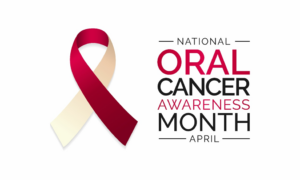
Oral cancer is a menace; and though this disease often flies under the radar, it has the potential to cause serious lasting damage to your smile—or worse. But by understanding the risk factors, symptoms, and importance of routine screening and preventive care, we can empower ourselves to combat this disease effectively. In recognition of Oral Cancer Awareness Month this April, here’s some useful information about oral cancer, as well as some ways you can actively lower your risk and enjoy a lifetime of happy, healthy smiling!
A Closer Look at Oral Cancer
Oral cancer refers to cancer that develops in any part of the mouth, which can include the lips, gums, tongue, inner lining of the cheeks, as well as the roof and floor of the mouth. This year alone, it’s estimated that around 55,000 new cases of oral cancer will be diagnosed—with several more cases remaining unrecognized and untreated. What’s worse is that roughly 40% of patients with the illness do not survive longer than five years, and those who do suffer lasting problems including facial disfigurement and eating and speech difficulties.
Perhaps what’s most haunting about these statistics is that the death rate associated with these cancers remains particularly high because they’re routinely discovered in their later stages! This is all the more reason that routine preventive dental care is so crucial—your dentist can easily identify any concerning symptoms and quickly implement treatment.
Common Oral Cancer Signs and Symptoms
You should always contact your dentist right away if there are any immediate concerns with your smile, as oral health issues will always worsen without intervention, whether they’re cancer-related or not. That said, a few signs and symptoms of oral cancer that you can keep a look out for include:
- Any sore or ulcerations that don’t heal within two weeks.
- Red, white, or black discoloration of the soft mouth tissues.
- Any abnormalities that bleed easily when touched.
- Hoarseness, a sore throat, or a persistent cough that doesn’t resolve within a few weeks.
- A swollen tonsil on just one side, often painless.
- A painless, firm, fixated lump felt on the outside of the neck.
- Difficulty swallowing, or the sensation that food is stuck in your throat.
- An earache on one side that persists for more than a few days.
How Can I Reduce My Risk of Oral Cancer?
Believe it or not, oral cancer is among the most preventable types of cancer, and there are several things you can do on your own to actively lower your risk. Consider these sensible tips:
- Routine preventive dental care every six months is the best way to stay on top of your smile’s wellness, and your dentist will perform a thorough oral cancer screening during each checkup.
- Maintain a detailed oral hygiene regimen at home by brushing, flossing and using an antibacterial mouthwash daily.
- Avoid bad oral habits like smoking or using tobacco products; these greatly increase your risk for various types of cancer, including those of the head and neck. Also, avoid drinking excessive amounts of alcohol.
The bottom line is that oral cancer is a serious yet preventable illness, but by taking great care of your smile and trusting your dentist, you’ll actively lower your risk of developing it. That said, don’t let April be the only month when you’re concerned about the disease; make it a lifelong endeavor to prevent it!
About the Practice
Here at Community Dentists of Worcester, we proudly offer a wide range of preventive, cosmetic, and restorative dental services to patients and families in the Worcester community. Every checkup also includes an oral cancer screening! If you have any questions about the blog or it’s time for your next appointment, please visit us online or call us today for information or assistance. Telephone: (774) 255-7345.






